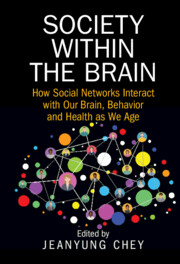Book contents
- Society within the Brain
- Society within the Brain
- Copyright page
- Dedication
- Contents
- Figures
- Tables
- Contributors
- Preface
- Introduction
- Part I Approaches to Society within the Brain
- Part II Society Interacting with Brain, Cognition, and Health in Late Life
- Part III An Individual’s Cognitive Aging with Others: Key Findings, Issues, and Implications
- Chapter 9 Social Relationships and Cognitive Function in Older Adults
- Chapter 10 Social Network and the Brain
- Chapter 11 Origins of Individual Differences in Social Behavior and the Social Brain
- Chapter 12 Preventing Dementia with Social Connection
- Index
- References
Chapter 11 - Origins of Individual Differences in Social Behavior and the Social Brain
from Part III - An Individual’s Cognitive Aging with Others: Key Findings, Issues, and Implications
Published online by Cambridge University Press: 28 September 2023
- Society within the Brain
- Society within the Brain
- Copyright page
- Dedication
- Contents
- Figures
- Tables
- Contributors
- Preface
- Introduction
- Part I Approaches to Society within the Brain
- Part II Society Interacting with Brain, Cognition, and Health in Late Life
- Part III An Individual’s Cognitive Aging with Others: Key Findings, Issues, and Implications
- Chapter 9 Social Relationships and Cognitive Function in Older Adults
- Chapter 10 Social Network and the Brain
- Chapter 11 Origins of Individual Differences in Social Behavior and the Social Brain
- Chapter 12 Preventing Dementia with Social Connection
- Index
- References
Summary
Humans are all different in how they behave and how their brains work in social contexts. This chapter reviews evidence regarding the origins of individual differences in social behavior and the social brain. It explores questions such as: How are genetic variations related to individual differences in social behavior and the social brain? How are environmental factors, such as socioeconomic status and early childhood experience, associated with individual differences in social behavior and the social brain? It also reviews how gene–environment interactions shape one’s social behavior and brain. Lastly, it highlights the critical role of adulthood experiences in social behavior and well-being in later life.
Keywords
- Type
- Chapter
- Information
- Society within the BrainHow Social Networks Interact with Our Brain, Behavior and Health as We Age, pp. 231 - 268Publisher: Cambridge University PressPrint publication year: 2023



